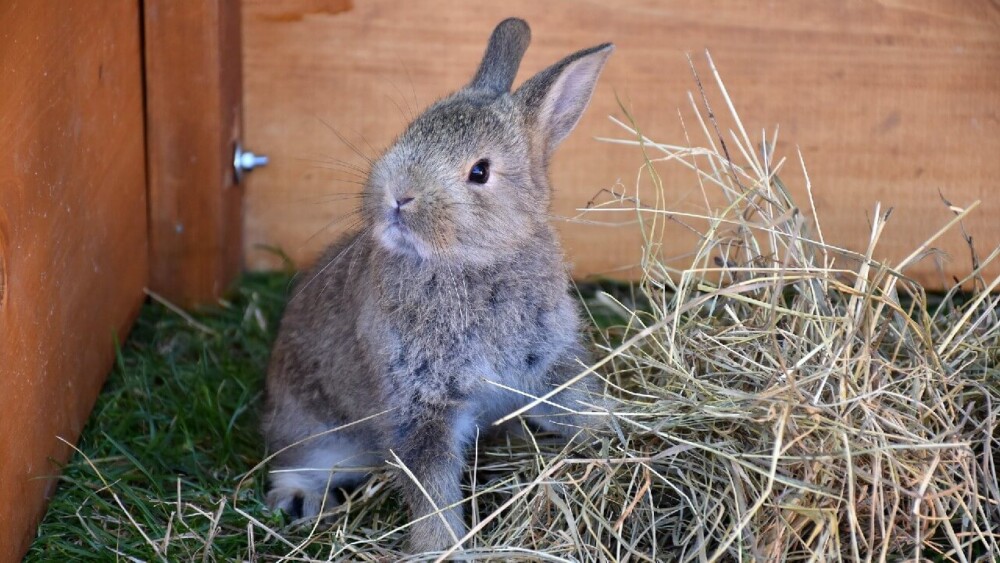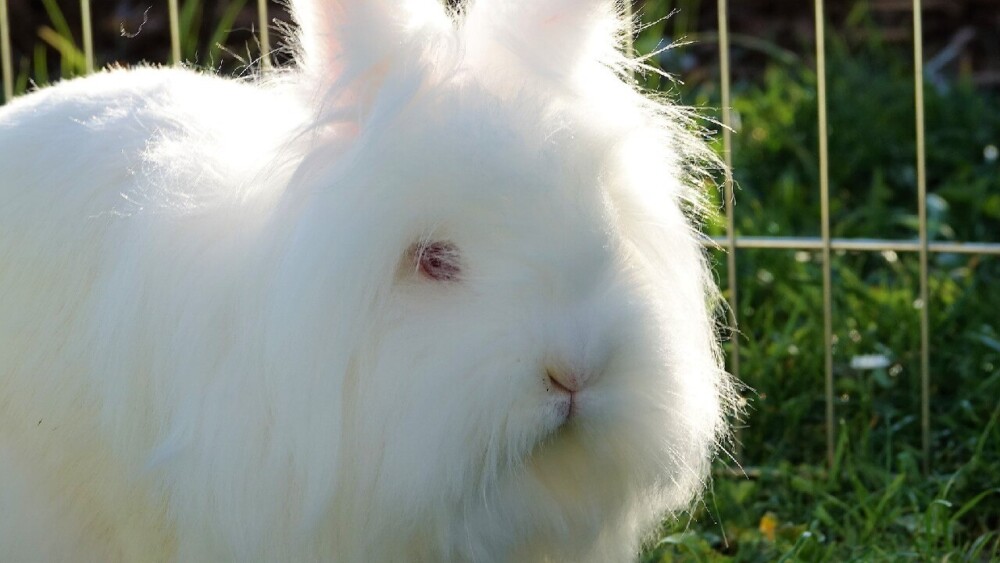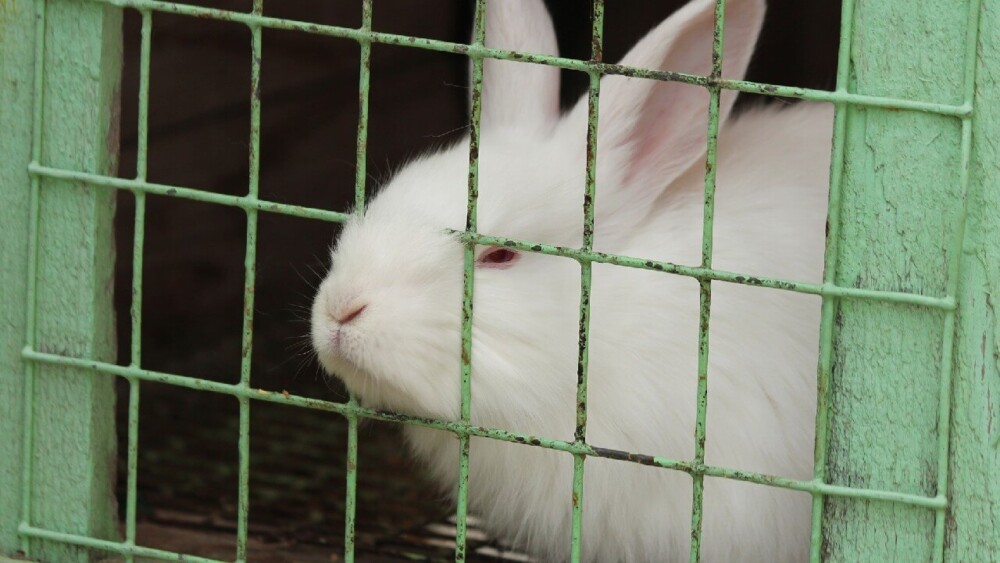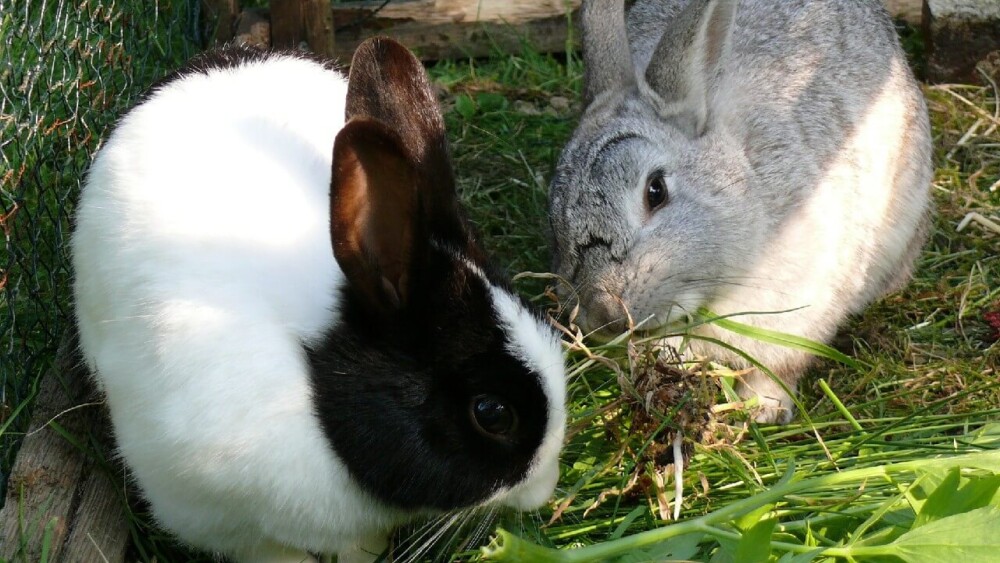Rabbits molt every year, but sometimes hair loss is caused by an underlying health issue. Rabbit owners need to understand the additional signs and possible causes of rabbit hair loss.
Why is my rabbit losing hair? Rabbits regularly lose hair when they molt, but abnormal hair loss can signify an underlying condition. Mites, parasites, dental issues, bullying, infections, and even pregnancy can cause your rabbit to have bald spots or rapid hair loss.
Molting is a regular event for rabbits (check out this article on molting). When molting is the only reason for hair loss, your bunny won’t act irritable, stressed, or sick. But, if the bare skin is red, scratched, or looks irritated, there may be another reason your rabbit is losing hair besides molt. Let’s take a look at other reasons for bunny hair loss.
Concerning Reasons for Fur Loss
Sometimes the loss of fur can be caused by an illness, dental, parasites, or simple over-grooming. Rabbits housed together may bully or fight each other.
Immediately isolate it from your other rabbits if your bunny shows signs of fur loss and skin irritation, redness, scratches, inflammation, lesions, or other concerning symptoms. Most bacterial infections and rabbit parasites are highly contagious. Do not wait to treat your rabbit. It will not get better on its own.
Pregnancy or False Pregnancy
Rabbits pull out large amounts of their hair when they are pregnant. Since a rabbit’s pregnancy is only about a month-long, it doesn’t take long after they conceive before they start nesting. Sometimes nesting is the clue that owners recognize a pregnancy by.
Doe’s start to nest by pulling out hair and mixing it with hay to prepare for her litter of kits. It’s a fantastic process and allows babies to survive in the wild, even during the winter. Doe’s living with a buck will often pull his hair to use for the nest. Most bucks allow this trait.
What if your rabbit can’t possibly be pregnant?
If your rabbit lives with another doe, alone, or with a wether, her body may still be acting as if she’s pregnant. Rabbits can pull hormones from another rabbit and have a false pregnancy. It’s also referred to as a phantom pregnancy. In a false pregnancy, the hormones and ovary signal a pregnancy, and your rabbit will show signs of pregnancy and nesting.
False pregnancies can occur because of the sexual stimulation of being mounted, even from by another doe. It can also happen because of high stress. Rabbits can occasionally ovulate during periods of high stress. False pregnancies last about 18 days instead of 31.
If your rabbit has a false pregnancy, you can usually treat the problem by getting her sprayed. This will prevent most false pregnancies going forward.
Bullying, Fighting, and Grooming
Rabbits are very territorial, especially the doe’s. And, it can take a while for rabbits to bond with each other if they didn’t grow up together. As a result, they will fight for a while. This can can result in biting and hair pulling or other injuries.
Grooming is also a common sign of dominance between rabbits. Usually, doe’s will groom a lower doe or a buck. It is not a sign of bonding.
Separate rabbits that are grooming or barbering each other. This will stop the dangerous behavior and allow you to see if the hair loss stops.
Dental Problems Cause Grooming Problems
Dental issues can cause problems with grooming. Rabbits self-groom daily. Make sure you check on their teeth regularly to make sure they don’t develop a severe condition,
Severe dental issues can cause rabbits to starve because it hurts too much to eat. Dental problems are most common among dwarf and lion head rabbits. Other rabbit breeds with small, rounded faces also tend to have more frequent issues.
Give your rabbits plenty of fiber, fruit, wood, and the best diet they can get to avoid most dental problems.
Overgrown Teeth
If your rabbit has overgrown teeth, you will notice that the front teeth are noticeably sticking out of the mouth. Rabbit’s teeth grow continually. In the wild, they are constantly munching, and domesticated rabbits want to nibble all day also. But, sometimes, a rabbit doesn’t get enough roughage to keep their teeth trimmed naturally. Some owners don’t realize how much a rabbit needs to munch all day.
Often if you see the front teeth overgrown, it means the back teeth are also overgrown. Overgrown teeth make it hard for rabbits to self-groom. They may try to groom and instead pull large chunks or whole patches of hair off.
This is made even worse if the teeth chip or break, a common occurrence with overgrown teeth. You can offer your rabbits tree sticks. Fruit trees such as apple, peach, or cherry are suitable for rabbits. You can also purchase bundles of tree sticks for your rabbit.
Signs of overgrown teeth:
- Curving teeth that stick out of the lips
- Drooling
- Wet chin
- Matted fur around the chin
- Loss of appetite
- Increased drinking
- Grinding of teeth
Your vet can trim your rabbit’s teeth. You can help reduce the odds of overgrown teeth by providing plenty of fiber and roughage to its diet. Hay, leafy greens, and sticks are great options to give your rabbit.
Rabbits should have unlimited access to hay (check out what kind is best here). Their teeth continually grow because rabbits need to munch and chew all day. Rabbits should seldom be fed pellets as they are over-packed with calories for the amount of chewing the rabbit must do to eat it.
Tooth Root Abscess
A tooth abscess is when the root of a tooth gets infected. Rabbits with overgrown teeth need to be treated. Dental problems cause eating complications and can contribute to bacterial infections and worsen parasites. The gums of your rabbit will fill with puss. It’s very painful. Your rabbit will stop eating or grooming itself because of the pain. A tooth abscess will need a vet’s care to be taken care of. It may require surgery or tooth removal.
Signs of a tooth abscess include:
- Wet chin
- Loss of fur around the chin
- Loss of appetite
- Swollen face or jawline on one side
- Loose teeth
- Swollen gums
- Prefers soft foods to harder foods
- Extreme weight loss
- Overgrown teeth
Parasites that Cause Hair Loss
Rabbits get four different types of mites, Sarcoptic, Mange, Fur Mites, and Ear Mites. Each of these can lead to specific patterns of hair loss. Additionally, fleas, lice, and ticks can cause skin irritation but usually don’t lead to widespread hair loss. But, irritation from parasites can cause secondary bacterial infections.
Sarcoptic Mange Cause Scabs and Hair Loss
Sarcoptic Mange is caused by burrowing scabie mites that irritate your rabbit, causing it to scratch. This can cause fur loss. The first signs of sarcoptic Mange show alopecia, scaly skin, or scabs. They are found mainly around the ears that can put off a foul smell.
More advanced signs can present as a white or beige crust around the ears, eyes, mouth, nose, and genitalia. Treat sarcoptic Mange fast to stop the spread of mites from one rabbit to another. Otherwise, you’ll have a significant problem on your hands. Keep an eye out for these symptoms.
- Scaly skin
- Scabs
- Foul smell
- Alopecia
- White or beige crust around the face and genitalia
Sarcoptic Mange Treatment
Many treatments for Sarcoptic Mange require a vet’s prescription. Take care to keep medicines stored appropriately as heat can compromise their effectiveness.
Treat Sarcoptic Mange with Ivermectin, Selamectin, and Fluralaner. Ivermectin is the only prescription approved for rabbits. You should also change your rabbit’s bedding daily. Isolate infected rabbits and be aware that mites can transmit to other pets and to people.
You might have to treat the other rabbits because mites can infect your whole colony. You will also want to clean all grooming tools before using it on other rabbits.
- Ivermectin: Ivermectin is the most widely used medicine for mites. It’s very effective but can cause some issues in pregnant rabbits, so talk to your vet if your rabbits could be pregnant. Follow the correct dosages for your rabbit’s weight, or you could cause an overdose in your rabbit.
Ivermectin is an anti-parasite medicine and is the most well-known out of all these products. Ivermectin is known to kill parasites like sarcoptic mites, psoroptes cuniculi, and most of the other parasitic pests listed that might infest your rabbit. Please don’t give it to pregnant or nursing doe’s because it could affect their kits.
- Selamectin: Selamectin is sometimes used off-label for rabbits. It Is also known as Revolution, stronghold, selehold, paradyne, xelamec, and clearkill smt. It is an avermectin antiparasitic made for cats and dogs but some vets use it on rabbits. Apply it topically every month on rabbits eight weeks and older. Studies have shown that’s its safe for pregnant and nursing cats and dogs but, rabbits haven’t been studied.
Make sure your rabbit is dry, and avoid getting your rabbit wet for two hours after applying. This gives time for your rabbit to absorb it into the skin.
- Fluralaner: Administer Fluralaner orally or topically. A single oral dose is effective for up to 90 days and can also help with ear mites that cause ear cankers. Remember that getting rid of sarcoptic mites is a challenge and could take a while to get rid of an entire infestation. Fluralaner use for rabbits is off- or extra-label use for rabbits. Avoided it in animals with a history of seizures.
Fur Mites Cause Baldness Along the Backside
Fur mites are non-borrowing mites and live on the surface of rabbits’ skin. They usually infest long-hair rabbits the most. Fur mites are also known as walking dandruff because you can see them with the naked eye.
If you notice patchy, flaking skin on your rabbit, it’s probably fur mites. They cause large quantities of dandruff and the mites themselves can look like moving dandruff.
If you see missing hair, look at your rabbit’s skin for dandruff flakes.
Fur mites can transfer to humans or other pets. They can also live in your carpets and fabrics for 10 days, and the eggs are harder to kill.
Even if you only hold an infected rabbit for a short period, you can pass the mites to people, causing itchy and irritated skin. You will want to quarantine and treat your rabbit. Obesity, dental problems, and a possible spinal disorder can cause an infestation of fur mites. Look out for these symptoms.
- Hair loss on the neck, along the back, shoulder blades, and rump
- Excessive itching
- Dandruff like flakes that move
- Flaky skin
- Lesions
Fur Mite Treatment
Treat fur mites with Ivermectin or Selamectin. Only use the vet’s prescription versions of these medicines for your rabbit’s safety. Over-the-counter versions are not safe for rabbits. Isolate the affected rabbit. Change your rabbit’s bedding and treat all of the environment your rabbit has been around.
This includes carpet, beds, couches and draperies—vacuum with a HEPA Vacuum. You can wash your rabbit carefully to clean most of the mites off of it.
Fluralaner: Used off-label or extra-label. It works for both fur mites and sarcoptic mites. One oral dose can work up to 90 days. This medicine is for dogs and cats, so please talk with your vet about administering it to your rabbit.
Selamectin: also known as Revolution in the US or Stronghold in the UK, can be given to your rabbit once every three to four weeks for two to three treatments.
Ivermectin: you have the choice of topical or oral, once every 10 to 14 days for two to four treatments. Ivermectin is the most popular treatment. If your give too much Ivermectin, it can be dangerous because rabbits ingest it.
Ear Mites Create Crusty, Bare Patches Around the Ears
Ear mites infect your rabbit’s ears. In the beginning, they are hard to detect because they crawl deep into the ear canal. Eventually, they multiply enough to make crusty spots on the ears. You may notice inflammation, earwax buildup (it may turn a darker color), and scabs or crust around the ears.
Ear mites will become visible in a more progressed infestation. They will become more painful and uncomfortable for your rabbit. You may find that your rabbit gets anxious when you feel or inspect the ears. It may flinch. Eventually, your rabbit will start eating less food.
Ear mites stay on the skin’s surface and are easily spread from one rabbit to another if they are housed together. Ear mites are more common in rabbits with lopped ears. That’s because their ears
Symptoms of ear mites include:
- Crusty build up of ear wax on and in the ear
- Flinching when you touch the ears
- Head tilt
- Appetite loss
- Excessive scratching
- Head shaking
- Wounds or cuts from scratching
- Cold-like symptoms
- Inflammation in the ear or the ear canal
- Fur loss around the ears
Check your rabbit’s ears regularly so that you can catch ear mites in the early stages. Check both the inner and outer ear canal. Look for wounds, scabs, flakes, or scaly skin. Watch for lots of ear wax. A little is expected. Ear wax is a pale, creamy color.
Next, feel for lumps around the ear, and its opening. If you find any signs of mites, contact your vet for a complete check-up.
Ear Mite Treatment
Treat your rabbit for ear mites with Ivermectin, Selamectin, or Fluralaner. Only use prescription versions of these medicines. They will be free of additives that can harm rabbits. Over the counter, versions are usually not for rabbits specifically. Clean their enclosure and surrounding space. Get rid of old bedding every day.
Ear mites can live up to 21 days off their host, depending on conditions. Keeping a clean environment during treatment is a must. Make sure to clean any grooming tools you may have used on an infected animal.
Ivermectin: Injections of ivermectin can be given every two weeks for two to three doses.
Selamectin: Use Selamectin as a monthly topical spot treatment.
Fluralaner: Fluralaner is an oral treatment for ear mites. One dose works up to 90 days.
Olive Oil: If you see your rabbit shaking their head and minor crusting on the ear, you can try a few drops of olive oil in the ear. As your rabbit shakes his head, the oil will get where it needs to go and help with the ear mites.
Only use this method at the very beginning stages. If your rabbit’s ear is really crusty, you will have to seek a vet for the other medicines. I’d also recommend having a vet check for secondary infections. They are pretty common.
Bacterial Infections
Rabbits can get a few bacterial infections that can lead to fur loss in rabbits like Pasteurella Multocida, Pseudomonas aeruginosa, and Staphylococcus warneri. Bacterial infections thrive in a humid environment, especially those caused by urine scald, bite wounds, and over salvation. This can lead to fur loss and skin irritations, causing abscesses. Let’s dive into the most common bacterial infections.
Rabbit Snuffles (Pasteurella Multocida)
Pasteurella Multocida, or snuffles, is the most common bacterial infection in rabbits. Snuffles will quickly spread throughout your colony, and some rabbits don’t show symptoms or only show symptoms when they are stressed. That can make it hard to manage.
Pasteurella Multocida is the most common cause of respiratory diseases in rabbits. Snuffles cause a “runny nose” with a discharge, respiratory infection that looks similar to a cold. But it’s a lot worse than a cold is for a person.
Pasteurella infects the eyes, lungs, ears, bloodstream, and skin. Rabbits get crusty “sleepy bugs” in their eyes. You may notice lesions in the eyes, skin, and internally. Lesions can grow very large.
Lesions can have hair loss around them. But, I hope that you will notice other more prevalent symptoms of your sick rabbit before the hair loss occurs.
- Fur loss around the mouth
- Sneezing
- Lesions on the skin, face, or around eyes
- Watery eyes
- Head tilt
- Crusty “sleepy bugs” around the eyes
- Nasal discharge
- Difference in breathing
- Cold-like symptoms
Snuffles Treatment
The most effective way to treat Pasteurella is with antibiotics. You will get more effective antibiotics from your vet. You can purchase diluted antibiotics at the farm store. You may end up using antibiotics for long periods, which can play havoc with your rabbit’s gut.
It’s critical to treat your rabbits as soon as they show signs of sniffles, and your vet can confirm the diagnosis. Because Pasteurella multocida is super contagious, isolate all rabbits that show any signs of illness.
It can pass from you handling multiple rabbits and not washing your hands in between. It can pass through brushes, feces, and shared cages.
It’s tough to control. Even after your rabbit recovers, it may still host the bacteria in the nasal cavities and have future flair-ups of snuffles.
Snuffles can result in death. Some rabbits are asymptomatic and only show symptoms when they are stressed. Other animals, new rabbits, children, poor nutrition, overcrowding, and unsanitary conditions can cause stress.
Green Fur Syndrome (Pseudomonas Aeruginosa)
Pseudomonas Aeruginosa, or Green Fur Syndrome, is a bacterial infection found in rabbits. It’s usually caused by an over moist dewlap or fold of skin. Overweight rabbits are at greater risk of Green Fur Syndrome.
Pseudomonas Aeruginosa thrives in moist conditions. Rabbits can also get Green Fur Syndrome when they live in a wet environment. Spilled water, leaky water bottles, dental problems (and drooling), and obese rabbits are the most common risk factors for Green Fur Syndrome. Dental problems may cause excessive drooling, which can bring it on.
Pseudomonas Aeruginosa can cause a blue-green discoloration of the fur. Typically seen in rabbits with moist dermatitis that affects the face, chin, and dewlap and is caused by humid, damp conditions and can grow in distilled water.
- Blue-green discoloration of fur
- Abscesses
- Lesions
- Loss of fur
Pseudomonas Aeruginosa Treatment
Carefully cut the discolored fur away from the area and treat with a topical antibiotic prescribed by your vet. If more severe, you will need to go to the vet to get the correct internal antibiotic for the infection. Some owners confuse it with Staphylococcus warneri, for they have the same symptoms.
Conclusion
If you notice abnormal baldness, shedding, or concern about an unusual molt, check for skin problems. Rabbits are fragile, beautiful animals, and they depend on you to take care of them.
Recommended Rabbit Supplies
This list contains affiliate products. Affiliate products do not cost more but helps to support BestFarmAnimals and our goal to provide farm animal owners with accurate and helpful information.
Housing: If your rabbit is indoor, you’ll need a cage, a hideout (to keep your rabbit from death by heart attack), and a space for it to get exercise and spend time with you. If you don’t want to let it run free in your house, this animal playpen provides space and keeps your rabbit from hiding under your couch.
If you keep your rabbit outdoors, an outdoor hutch that provides space and protection from predators is needed. (I’d still keep mine in a barn for further protection from the elements.)
You’ll also need bedding, toys, a grooming brush, and treats for your little friend. A litter box is important because rabbits can be potty trained. Timothy hay is the best kind of hay for rabbits as alfalfa is too sweet. Don’t forget a water drinker. I like the half-gallon waterer because it can cover two rabbits for several days. Pair it with a food bowl or a food manger (a little cleaner) and you’ll be set up!
If you want to treat your bunny to entertainment, a cat tower, a treat ball, or bunny toys all work wonderfully.
Finally, if you plan on taking your rabbit with you on trips, you’ll need a carrier. Here’s a small carrier or larger carrier that work great for occasional travel. If you travel a lot, you might want the carrier that’s rated #1 in safety for safe travels
Lastly, I use this odor eliminator for accidents and to wipe out the bottom of the cage and litter box when I clean it.





